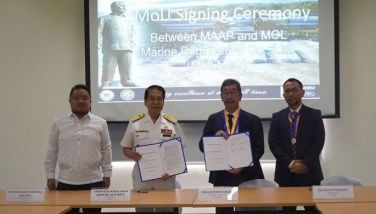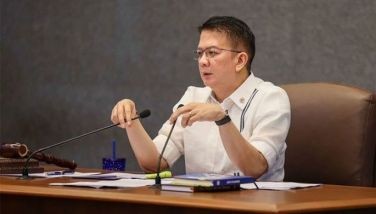Where hunger could be a stranger - I
January 27, 2007 | 12:00am
This isn't strictly a travelogue, but more of spontaneous impressions that itch for expression after a few days sojourn in picturesque City of Butuan, nestled in the long promised, and still promising, future in rich Mindanao seeking fulfillment.
Butuan and the outlying towns used to be the favorite destination of Cebuano migrants seeking greener pastures. While remaining Sugbuanon at heart, they and their later generations have learned to find a second home and a haven to love.
Many close relatives and childhood neighbors have gone co-mingling with Butuanons over time. The friendly and peace-loving Butuanons are markedly Cebuano in influence. In speech and mannerisms, including their vocabulary, intonation, and colloquialisms, they give away the Sugbuanon nuances.
This time around on a fourth visit, one's and wife Virgie's happy excuse was to attend the fourth birth anniversary of bright and bubbly granddaughter, Danielle, the apple of the eye of our physician son Leo and his petite wife Bambam of Butuan City.
At the back of one's mind was the chance to overturn the tactless and wrong articulation of ABS-CBN's Tony Velasquez for one, who senselessly slants "Butuan" as "Butu-an", obviously an attempt at sophistication. To put things right, it is correctly pronounced as "Butwan", not "Butu-an" which sounds demeaning.
National Musuem-Butuan Branch OIC Linricon A. Absuelo has this info...The etymology of Butuan could be from "butwan", a sour fruit-bearing tree then growing along the Agusan River; or from Datu Butuan who once ruled the place of yore, or, from the term "buotan" describing the orig natives whose ancestors procreated the still extant Manubo Lapaknon of Barangay Babag, now fully accultured with contemporary Butuanons. The most plausible version came from the historical curio found in ancient Javan script, etched or engraved with the word "Butwan" on a stamping seal relic.
What is intriguing is the running claim of many Butuanons and their officialdom that the first Catholic Mass was not in Limasawa, but in Butuan which was then already a thriving community. Its varying version alternatively points to the seacoast Magallanes town near Butuan facing the now Butuan Bay.
Few decades ago circa martial law, there was a three-week seminar in Tagaytay City jointly sponsored by the Civil Service Commission, Depts. of Finance and Local Governments, attended by LGU supervisory personnel who were later conferred CESO eligibility.
Butuan City was represented by Rev. Benjamin Orteza who, during sidling discussions on the historical origin of the barrio government, heatedly argued for Butuan as the "accurate site" of the First Mass. One recalls a couple of Rev. Ben's arguments, thus: 1) that the locational bearing of Magellan's navigator using solar-based latitude and crude longitudinal reckoning, pinpoints the First Mass on March 31, 1521 as in Butuan; 2) that it was held at the mouth of extant Masao River in Butuan, which could have given rise to the name Limasawa. He also cited some artifacts dug up in Butuan, but one can not now recall.
Whichever is the accurate history, many Butuanons are gung ho in claiming the First Mass as celebrated in Butuan, not somewhere else. However, historians relying on Pigafetta's accounts, including the Philippine Historical Society do not buy such version. What's interesting could be an overhaul of that aspect of early Philippine history, that is, should future historical and geological findings prove the Butuanons' claim.
Putting aside such historical enigma that besets them, the most defining worth of Butuan is its people and its natural endowments and, when properly harnessed, will defy the scourge of hunger. (To be continued)
Email: lparadiangjr@yahoo.com
Butuan and the outlying towns used to be the favorite destination of Cebuano migrants seeking greener pastures. While remaining Sugbuanon at heart, they and their later generations have learned to find a second home and a haven to love.
Many close relatives and childhood neighbors have gone co-mingling with Butuanons over time. The friendly and peace-loving Butuanons are markedly Cebuano in influence. In speech and mannerisms, including their vocabulary, intonation, and colloquialisms, they give away the Sugbuanon nuances.
This time around on a fourth visit, one's and wife Virgie's happy excuse was to attend the fourth birth anniversary of bright and bubbly granddaughter, Danielle, the apple of the eye of our physician son Leo and his petite wife Bambam of Butuan City.
At the back of one's mind was the chance to overturn the tactless and wrong articulation of ABS-CBN's Tony Velasquez for one, who senselessly slants "Butuan" as "Butu-an", obviously an attempt at sophistication. To put things right, it is correctly pronounced as "Butwan", not "Butu-an" which sounds demeaning.
National Musuem-Butuan Branch OIC Linricon A. Absuelo has this info...The etymology of Butuan could be from "butwan", a sour fruit-bearing tree then growing along the Agusan River; or from Datu Butuan who once ruled the place of yore, or, from the term "buotan" describing the orig natives whose ancestors procreated the still extant Manubo Lapaknon of Barangay Babag, now fully accultured with contemporary Butuanons. The most plausible version came from the historical curio found in ancient Javan script, etched or engraved with the word "Butwan" on a stamping seal relic.
What is intriguing is the running claim of many Butuanons and their officialdom that the first Catholic Mass was not in Limasawa, but in Butuan which was then already a thriving community. Its varying version alternatively points to the seacoast Magallanes town near Butuan facing the now Butuan Bay.
Few decades ago circa martial law, there was a three-week seminar in Tagaytay City jointly sponsored by the Civil Service Commission, Depts. of Finance and Local Governments, attended by LGU supervisory personnel who were later conferred CESO eligibility.
Butuan City was represented by Rev. Benjamin Orteza who, during sidling discussions on the historical origin of the barrio government, heatedly argued for Butuan as the "accurate site" of the First Mass. One recalls a couple of Rev. Ben's arguments, thus: 1) that the locational bearing of Magellan's navigator using solar-based latitude and crude longitudinal reckoning, pinpoints the First Mass on March 31, 1521 as in Butuan; 2) that it was held at the mouth of extant Masao River in Butuan, which could have given rise to the name Limasawa. He also cited some artifacts dug up in Butuan, but one can not now recall.
Whichever is the accurate history, many Butuanons are gung ho in claiming the First Mass as celebrated in Butuan, not somewhere else. However, historians relying on Pigafetta's accounts, including the Philippine Historical Society do not buy such version. What's interesting could be an overhaul of that aspect of early Philippine history, that is, should future historical and geological findings prove the Butuanons' claim.
Putting aside such historical enigma that besets them, the most defining worth of Butuan is its people and its natural endowments and, when properly harnessed, will defy the scourge of hunger. (To be continued)
BrandSpace Articles
<
>
- Latest
- Trending
Trending
Latest
Trending
Latest
Recommended

February 22, 2025 - 12:00am


























